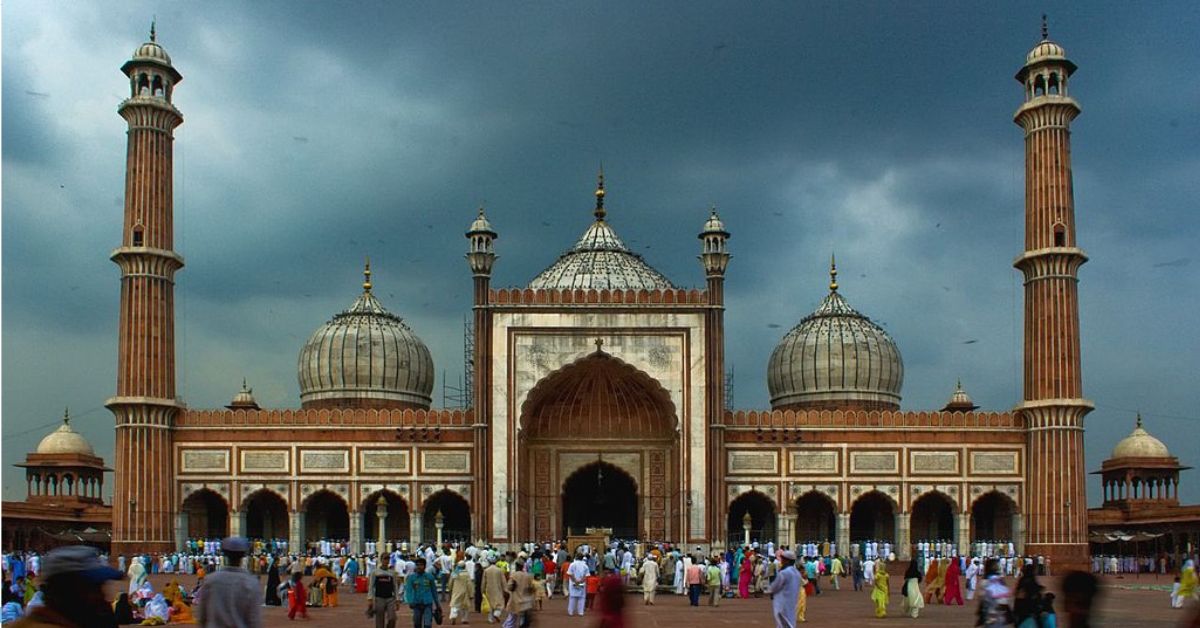Right in the heart of Old Delhi, you’ll find Jama Masjid – a stunning example of Mughal architecture. Built by the famous Emperor Shah Jahan, who also made the Taj Mahal, it took twelve years to finish, from 1644 to 1656. This huge mosque is not only the biggest in India but also one of the most beautiful.
With its tall minarets, grand domes, and big courtyard, Jama Masjid is like a picture from a history book. It’s a special place for everyone – people who love history, those who admire beautiful buildings, and even travelers looking for a peaceful spot. Let’s explore this amazing place together and learn about its fascinating story, beautiful design, and lively atmosphere.
How to reach:
Metro:
The quickest way is to take the Delhi Metro. Get off at Jama Masjid station on the Violet Line. It’s just a short walk from there. Or, you can get off at Chawri Bazar station on the Yellow Line and walk for about 10-15 minutes.
Bus:
You can take a Delhi Transport Corporation (DTC) bus to Red Fort or Chandni Chowk. Both places are close to Jama Masjid. From there, you can walk or take a rickshaw.
Rickshaw:
Auto-rickshaws and cycle rickshaws are everywhere in Delhi. They’re a good way to get around the narrow streets of Old Delhi. Make sure to agree on the price before you start.
Car or Taxi:
You can also use a car or taxi, but traffic can be bad, especially during busy times. Finding a parking spot is difficult, so it’s better to park near Red Fort or Chandni Chowk and walk.
Best time to visit:
Winter (October to March)
Winter is the perfect time to explore Jama Masjid. The weather is cool and comfortable, with temperatures between 5°C and 20°C. The clear sky makes the mosque look even more stunning.
Summer (April to June)
Summers in Delhi are very hot, with temperatures reaching up to 45°C. If you must visit during this time, go early in the morning or late in the evening. Don’t forget to bring water and wear light clothes.
Monsoon (July to September)
It rains a lot during the monsoon season, and it can be humid. While the rain can cool things down, it might be hard to get around Old Delhi. If you visit, be ready for sudden showers and bring an umbrella.
Attractions:
The Majestic Courtyard:
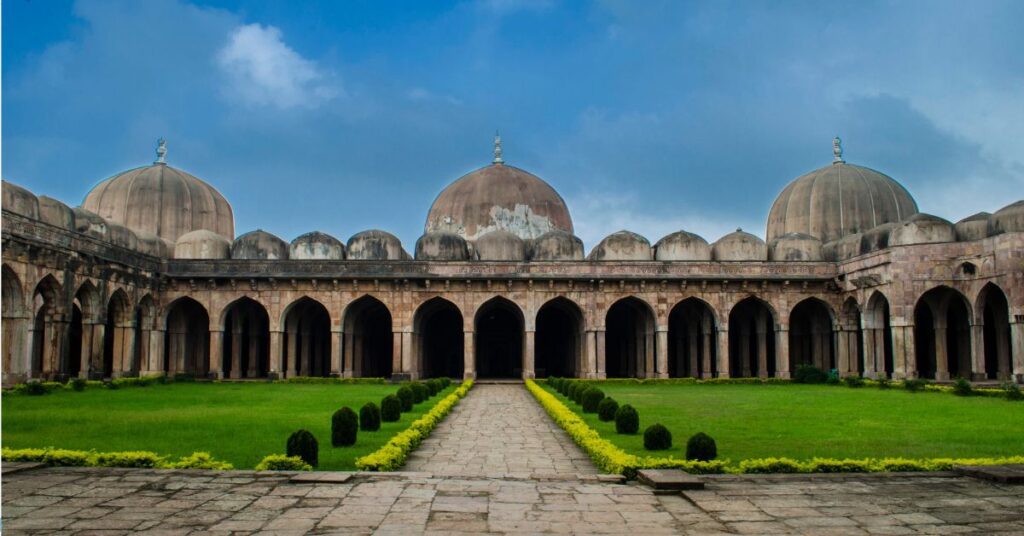
The Jama Masjid courtyard is huge! It’s big enough for 25,000 people to pray at the same time. Imagine that! It’s a peaceful space, completely different from the busy streets outside. The floor is made of red stone, and there’s a big water tank in the middle for washing before prayers.
On Fridays and special days, the courtyard is packed with people praying together. It’s a really amazing sight. Standing there, looking up at the tall minarets and domes, you feel small and peaceful. It’s a perfect place to just sit and admire the beauty of the mosque.
The Main Prayer Hall:
The main prayer hall is like a palace inside the mosque. It’s huge, with tall arches and beautiful marble carvings everywhere. The three big white domes with black lines are really eye-catching. Inside, there are pretty Persian carpets and the walls are covered in fancy designs and verses from the Quran.
Thousands of people can pray here at once. It’s a very peaceful place, perfect for thinking and praying. Visiting the prayer hall is like stepping back in time and learning about the history and culture of Islam in India.
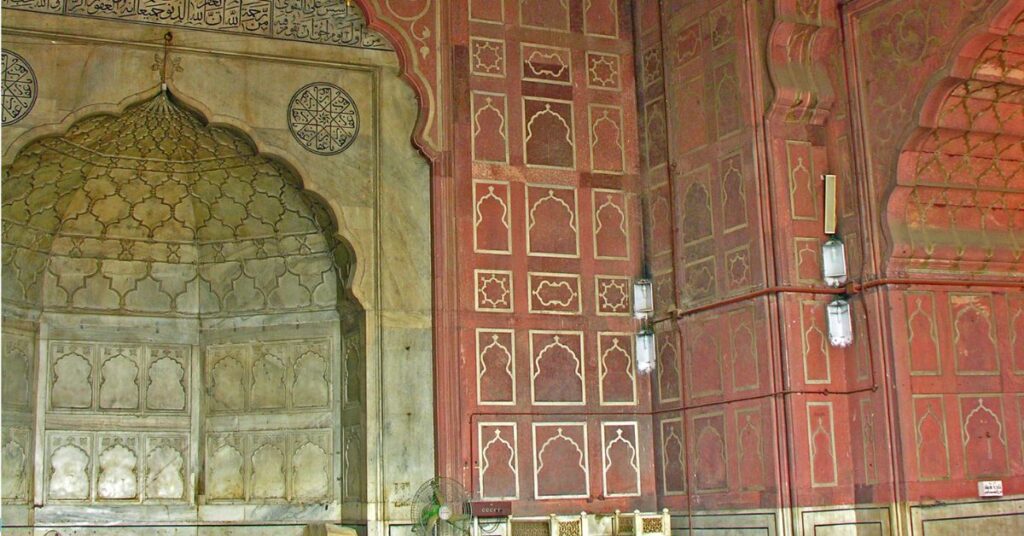
The Minarets:
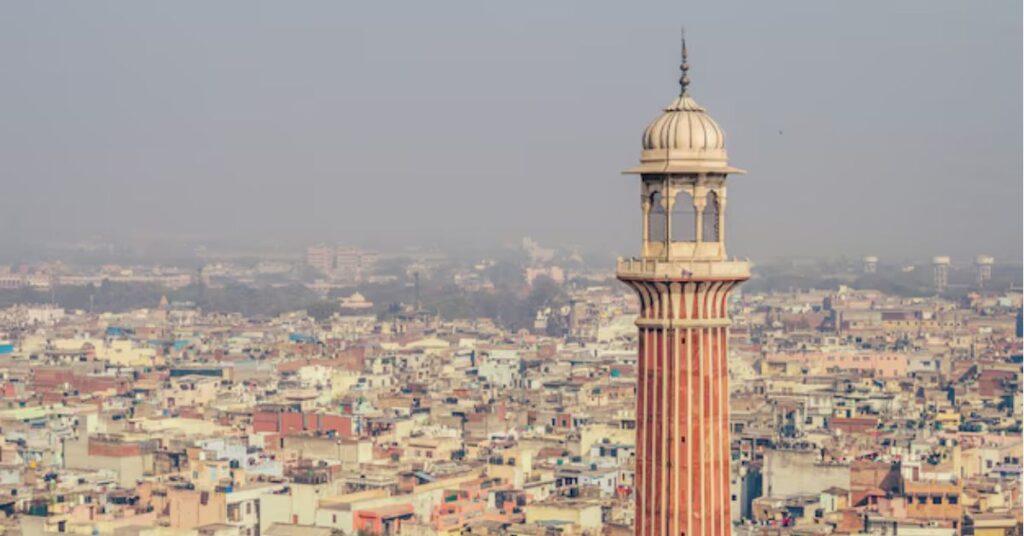
Jama Masjid’s minarets are like two giant towers, each standing tall at 40 meters. They’re made of beautiful red stone and white marble. Climbing up the south tower is like going on a little adventure. There are 130 steps, and it’s a bit tricky, but the view from the top is worth it!
You can see everything from up there – the busy streets, the big Red Fort, and even faraway parts of the city. It’s like looking down on a whole different world. The minarets are not just pretty to look at; they’re also where people call out to announce prayer time. They’re a really important part of the mosque and the city.
The Hauz (Water Tank):
Right in the middle of the courtyard is a big water tank called the Hauz. It’s not just for looks; it’s where people wash themselves before praying. It’s like a giant, clean mirror reflecting the beautiful mosque around it.
Sitting by the Hauz, you can really feel the peacefulness of the place. Watching people get ready for prayer there gives you a glimpse into their daily life and beliefs. It’s a special spot that adds to the magic of Jama Masjid.
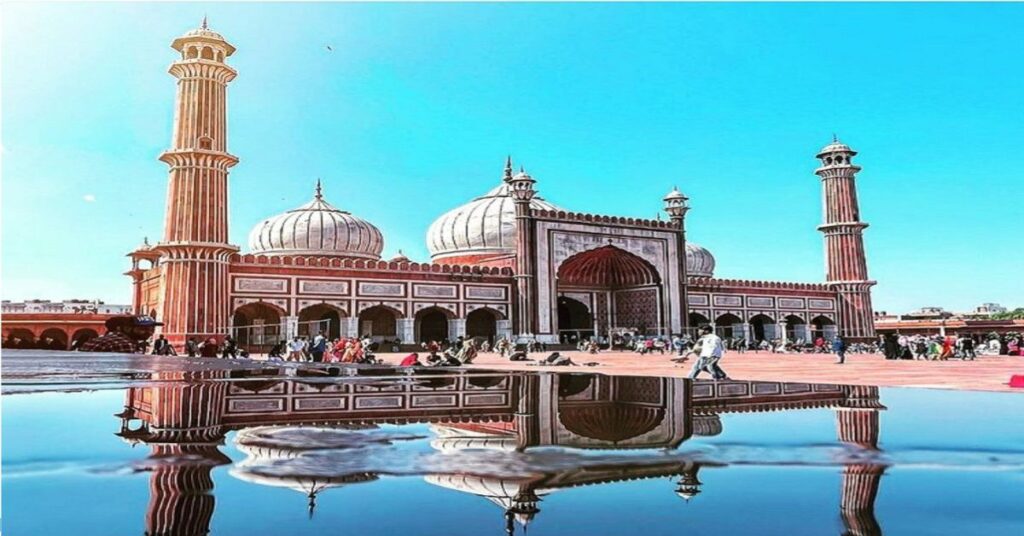
The Surrounding Markets:
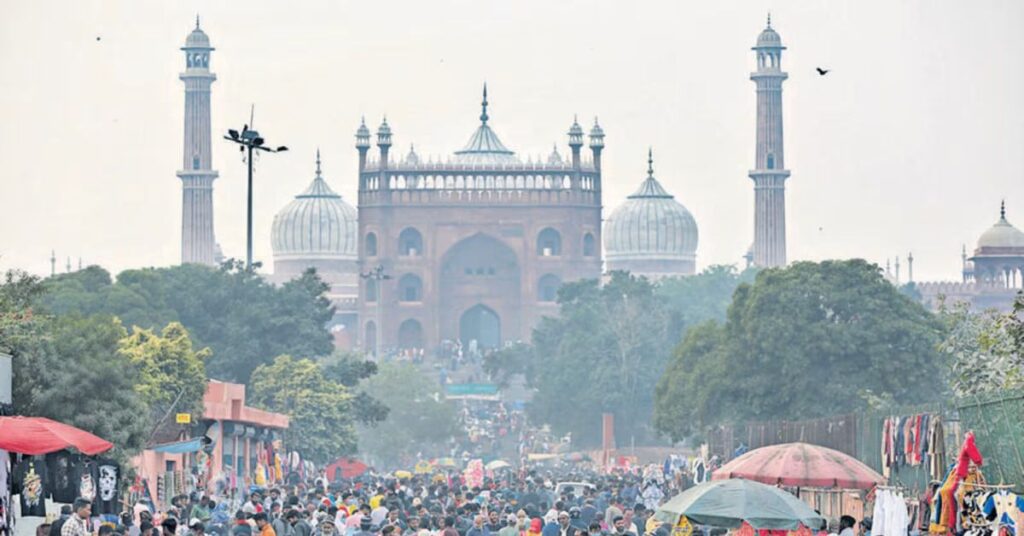
The area around Jama Masjid is a foodie’s paradise! Places like Karim’s and Al-Jawahar are famous for their delicious Mughlai food. The market streets are a colorful mix of sights, sounds, and smells. You can find all sorts of yummy street food, from spicy kebabs to sweet treats.
There’s more than just food though. The shops are full of interesting things to buy, like colorful fabrics, beautiful jewelry, and old antiques. It’s like stepping back in time while enjoying the modern buzz of the city.
Local Experiences:
- Morning Calm: Start your day with a peaceful visit during morning prayers.
- Sky-High Views: Climb the minaret for a breathtaking panorama of Old Delhi.
- Courtyard Serenity: Enjoy the tranquil atmosphere of the vast courtyard.
- Friday Gathering: Witness the impressive Friday congregational prayers.
- Capture the Beauty: Take stunning photos of the mosque’s intricate architecture.
- Culinary Journey: Savor delicious Mughlai food at famous local restaurants.
- Shopping Spree: Explore the vibrant markets for unique souvenirs.
- Discover History: Learn about Islamic culture at the on-site museum.
- Festival Fever: Experience the lively atmosphere during Islamic festivals.
- Evening Magic: Enjoy the mosque’s illuminated beauty at night.
- Local Connections: Interact with locals to gain a deeper cultural understanding.
- Street Food Delight: Indulge in a variety of tempting street food.
Travel Tips:
Check Opening Hours: Verify the mosque’s opening hours before your visit, as they may vary.
Respectful Photography: While photography is generally allowed, avoid taking pictures of people praying or during religious ceremonies.Guided Tours: Consider joining a guided tour to learn more about the mosque’s history and architecture.
Bargaining Skills: If you enjoy shopping, practice your bargaining skills in the local markets.
Hygiene: Carry hand sanitizer, especially when eating street food.
Weather Considerations: Check the weather forecast before your visit and dress accordingly.
Emergency Contact: Have a local contact number in case of any issues.
Conclusion
Jama Masjid, a magnificent symbol of India’s rich heritage, invites Xplro.com travelers on an immersive journey through history, architecture, and spirituality. This iconic mosque, with its grand scale and intricate details, offers a glimpse into the grandeur of the Mughal era. Beyond its architectural splendor, Jama Masjid is a living testament to faith and community. Explore the expansive courtyard, climb the towering minarets for panoramic views, and immerse yourself in the vibrant atmosphere of the surrounding markets. Discover the beauty of Islamic art and architecture as you explore this historic gem. Remember to respect local customs and dress modestly to honor the sacred space.
FAQs
1. What is Jama Masjid?
- Jama Masjid, also known as Masjid-i-Jahan-Numa, is a prominent and historically significant mosque in India, located in Old Delhi. Constructed by Mughal Emperor Shah Jahan between 1644 and 1656, it is one of the largest mosques in the country.
2. Where is Jama Masjid located?
- Jama Masjid is located in the heart of Old Delhi, near Chandni Chowk and opposite the Red Fort. Its address is Meena Bazaar, Jama Masjid, Chandni Chowk, New Delhi, Delhi 110006, India.
3. What are the visiting hours for Jama Masjid?
- The mosque is open to visitors from 7:00 AM to 12:00 PM and 1:30 PM to 6:30 PM every day. It is closed during prayer times, especially on Fridays.
4. Is there an entry fee for Jama Masjid?
- There is no entry fee to visit Jama Masjid. However, there is a small fee for climbing the southern minaret, and a fee may be charged if you wish to take photographs inside the mosque.
5. What is the best time to visit Jama Masjid?
- The ideal time to visit Jama Masjid is during the winter months (October to March) when the weather is cooler and more pleasant. Early mornings or late evenings provide a more peaceful experience with fewer crowds.
6. What should I wear when visiting Jama Masjid?
- Visitors should dress modestly, covering their shoulders and legs. Women may be required to cover their heads. Scarves and robes are usually available at the entrance if needed.
7. Can non-Muslims visit Jama Masjid?
- Yes, non-Muslims can visit Jama Masjid outside of prayer times. However, access may be restricted during certain religious ceremonies and prayer times.
8. How can I reach Jama Masjid?
- Jama Masjid can be reached by metro, bus, auto-rickshaw, or taxi. The nearest metro station is Jama Masjid on the Violet Line, and Chawri Bazar Metro Station on the Yellow Line is also nearby.
9. Are there guided tours available at Jama Masjid?
- Yes, local guides are often available at the entrance and offer guided tours for a fee. Hiring a guide can provide deeper insights into the history, architecture, and significance of the mosque.
10. Can I take photographs inside Jama Masjid?
- Yes, photography is allowed inside Jama Masjid, but there may be a small camera fee. Always ask for permission before photographing people, especially during prayers.
11. What other attractions are near Jama Masjid?
- Nearby attractions include the Red Fort, Chandni Chowk, Raj Ghat, and several bustling markets. These sites offer additional historical and cultural experiences, making for a comprehensive visit to Old Delhi.
12. Are there any food recommendations near Jama Masjid?
- Yes, the area around Jama Masjid is famous for its Mughlai cuisine. Popular eateries include Karim’s and Al-Jawahar, where you can savor authentic dishes like kebabs, biryanis, and more. Street food stalls also offer a variety of local delicacies.




